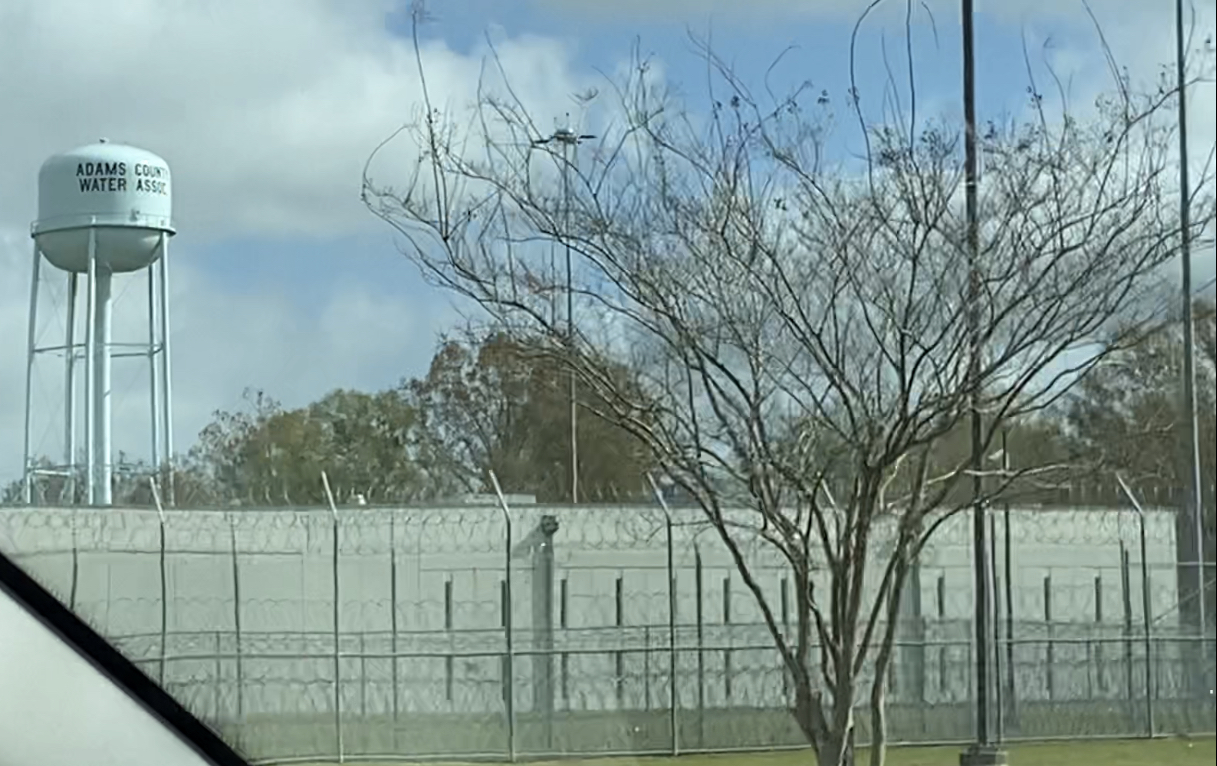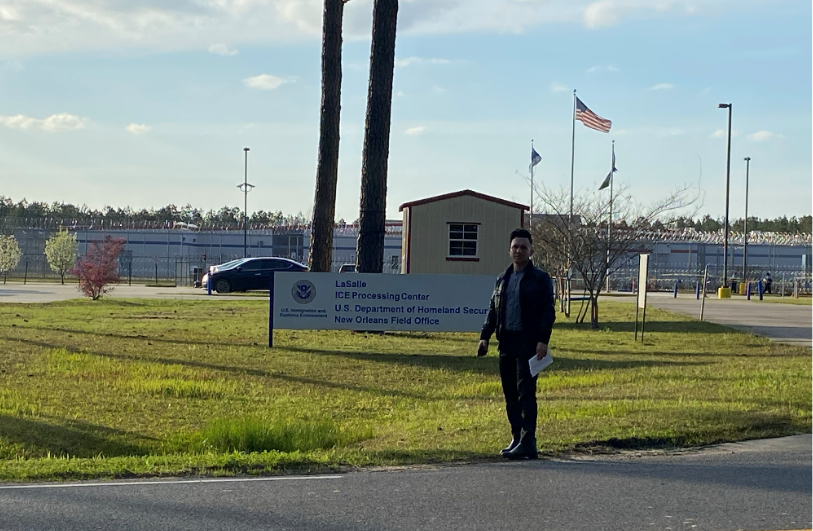Venezuelans Detained by ICE Face a Dangerous Limbo
Hundreds of Venezuelans seeking asylum in the United States are behind bars, risking COVID-19 infection and facing an uncertain future in the labyrinthine immigration system.


Image: Sofía Jaimes Borges
Entangled in a complex immigration system; several Venezuelans have been detained for more than a year. They’re not being punished for the commission of a crime: this is just how asylum seekers are treated nowadays in the US.
In early March, right before the world screeched to a halt, I was able to visit several detention centers between Louisiana and Mississippi. The goal was to talk with at least a dozen detainees that had an order of removal (commonly known as deportation order) and help them in their bids to be released. As an immigration attorney, I scheduled visits in advance with county jails and private contractors running massive ICE facilities. A leading activist for Venezuelan detainees, Edinson Calderón, came along to talk directly with the inmates.
With the COVID-19 pandemic, there’s an actual risk of infection, whereas the notoriously subpar medical facilities of ICE detention centers pose a risk to their lives.
With the COVID-19 pandemic, there’s an actual risk of infection, whereas the notoriously subpar medical facilities of ICE detention centers pose a risk to their lives. Gradually, many are being released with an option to get a work authorization, but the response is slow, and their subsequent immigration status is as flimsy as it gets.
The Cases
We carefully selected a group that was prioritized considering time in custody and health conditions. Regarding life in one of these centers, Edinson knew far more than me, as two years ago he was detained in Otay Mesa, fleeing political persecution in Venezuela. I represented him in his asylum case, and now that he’s waiting for a green card, he’s focused on helping others obtain their freedom.
We saw León, who had a months-old running cough. He told us he visited the medical facilities in that correctional center and the doctor gave him salt, for gargles. That was it. Another detainee, Ricardo, had an inflamed colon and was losing weight at an alarming pace, as his body could not tolerate the food they served. 18-year-old Lorena was separated from her parents and younger siblings, who were released days after arriving from Tamaulipas, and she remained detained for nearly a year. Néstor had never met his baby, his wife was pregnant when they crossed from Reynosa. All of them had been in detention for at least six months.
The vast majority of cases were of forced migrants who fled the crisis in Venezuela and thought of applying for asylum in the U.S. A regulation from July 2019, known as the transit bar to asylum, made it nearly impossible to replicate Edinson’s approval from just two years ago; this rule prevents a grant of asylum for anyone who travelled through a third country and didn’t have a request (and denial) for international protection.
For Venezuelans, stepping on another country before reaching American soil is unavoidable: all direct flights have been suspended since May 2019. The options left are forms of relief that are much harder to obtain. For example, under the Convention Against Torture, a person asking for asylum needs to show that it is more likely than not (at least 51%) that, if she’s returned to her country, she’ll be tortured, compared to a likelihood of severe damage of only 10%.
Even for those sidestepping asylum and just asking to be deported, prolonged detention is also a possibility. Take Andrés, who spent his 19th and 20th birthday in ICE custody. After overstaying his visitor visa, authorities arrested him during a routine check-up in northern Florida. He requested Voluntary Departure (a form of relief that cleans his record as long as he leaves by himself within four months), but he had no passport and couldn’t board a plane. ICE chose to keep him behind bars until he can leave.
How much longer can he remain detained? The clock starts not from the day he was arrested, but from the day his immigration case was terminated by the judge. After 180 days, it is arguably unconstitutional. Every 90 days, ICE should conduct a custody review, taking three matters into account: whether the person is a flight risk–which can be mitigated with ties to the US, such as family or a sponsor, and by offering a work authorization that will be revoked and exchanged for an arrest warrant if the person goes missing–, a danger to people or property–shown by a lack of criminal record or association with a criminal organization–, and whether it is likely that the detainee will be deported in the foreseeable future. Andrés has reputable sponsors and multiple family members legally in the US, he has never been charged with a crime, and with the suspension of US-Venezuela flights since May 2019 and the near impossibility of obtaining a new passport, his removal is as unforeseeable as it comes. Yet, the system is slow, somewhat arbitrary and the guidelines for agents are ambiguous at best.
A Pandemic in a Detention Center

Adams County Detention Center, where many Venezuelans are detained due to immigration irregularities. Photo by: Julio Henríquez, 2020.
Add COVID-19 to prolonged detention and you have a recipe for disaster. Consider these ubiquitous recommendations: practice social distancing, wash your hands constantly for at least twenty seconds, and avoid touching surfaces that may be contaminated. How can you keep social distancing in jail? Washing your hands cannot be done nearly as frequently as needed, and the cleaning within many of the centers operated by, or on behalf of ICE, is done by the inmates themselves.
As anyone can guess, the sanitation standards are not precisely high. A table or a chair that was touched by someone contaminated is not likely to be disinfected soon enough to prevent others from touching it as well. And the notoriously poor medical facilities cannot get away with giving a bag of salt for gargles to hundreds of coronavirus patients, as they did with León. Yet, we don’t have to speculate about these risks, we already know what can happen: according to the New York Times, the largest-known source of coronavirus infection in the US is the Cook County Jail in Chicago, and at least 1,324 cases and 32 deaths are connected to prisons and jails.
In light of the pandemic, advocates have filed cases across the country to procure the release of non-criminal immigrants held by ICE, with mixed results. A Venezuelan woman, María Alejandra, is the named plaintiff in the class action suit that, thus far, has been the most successful–the case can be found as Savino v. Souza. Of 147 detainees in Bristol County Jail, a Federal Judge in Boston has pledged to release at least 50. ICE lawyers have been pushing back against the releases, claiming that they can protect the detainees.
Freedom’s (Limited) Tools
There are useful, yet limited, avenues to secure the release of detainees, especially of those that cannot be deported in the foreseeable future. In fact, many of those mentioned in this article have already been released and are living with friends or family elsewhere in the US: León could see a more useful doctor to treat his cough (it wasn’t coronavirus), Ricardo is keeping a much healthier diet, and Néstor is spending a lot of time with his baby. Yet, Lorena, Andrés and María Alejandra are still fighting to be released.
The simplest action available is to present thorough packets for their custody reviews, which ICE should conduct every 90 days. This alone has helped in the release of hundreds of Venezuelans. For those who are still fighting their cases in immigration court, a request for parole is a good idea, although the likelihood of success isn’t too high. Yet, both custody reviews and parole requests are done on an individual basis. A class action suit is not out of the question, especially for those whose immigration cases are terminated. If and when a class action is filed, the jurisdiction is of paramount importance: federal judges in places like Louisiana, Mississippi and Florida, where the majority of Venezuelan migrants are held, are much less likely to side with the plaintiffs in this type of cases than federal judges in places like California, Massachusetts or Washington state.
Bringing freedom to the migrants is urgent, but another matter that cannot be ignored is their status once they’re released. People like León, Néstor and Ricardo received an order of supervision that requires periodic presentations before ICE offices and limits travel outside the state where they reside without prior approval. Yes, they can obtain a work authorization, but they continue to have an order of removal. Whenever it becomes practicable (for example, if US-Venezuela flights are restored or ICE secures a third country to facilitate transit), they will be deported. There’s a possibility to obtain another form of relief before that happens, but it’s an upside battle.

Edinson Calderón after his release. Photo: Julio Henríquez, 2020.
That is why proposals to grant some form of status to Venezuelans in the US are so important. There’s a bill in the US Senate proposing to grant Temporary Protected Status (TPS) to Venezuelans that would help not only those released from detention, but also thousands who are seeking asylum, on removal proceedings or overstayed their visas. Yet, Congress has other pressing priorities at this time, and even when it didn’t, this bill was still relegated to the bottom of the pile. With enough pressure, that bill could be voted on the floor of the Senate and prior rounds of voting show that it is likely to be approved. It just has to be rescued from that pile. Other alternatives are available, and the White House has hinted at the possibility of granting something similar to TPS: Deferred Enforced Departure (DED). Yet, despite the significant attention to Venezuela, the DED for Venezuelans in the US continues to be just an expectation.
Both options, TPS and DED, would grant a far more robust—if still temporary—status to thousands of Venezuelans rightfully afraid to return to a crisis-stricken country. In fact, if this is granted quickly, it would fix the urgent issue of detainees at risk of contracting COVID-19, turning the trickle of custody reviews and paroles for release into a hefty stream.
Caracas Chronicles is 100% reader-supported.
We’ve been able to hang on for 22 years in one of the craziest media landscapes in the world. We’ve seen different media outlets in Venezuela (and abroad) closing shop, something we’re looking to avoid at all costs. Your collaboration goes a long way in helping us weather the storm.
Donate




